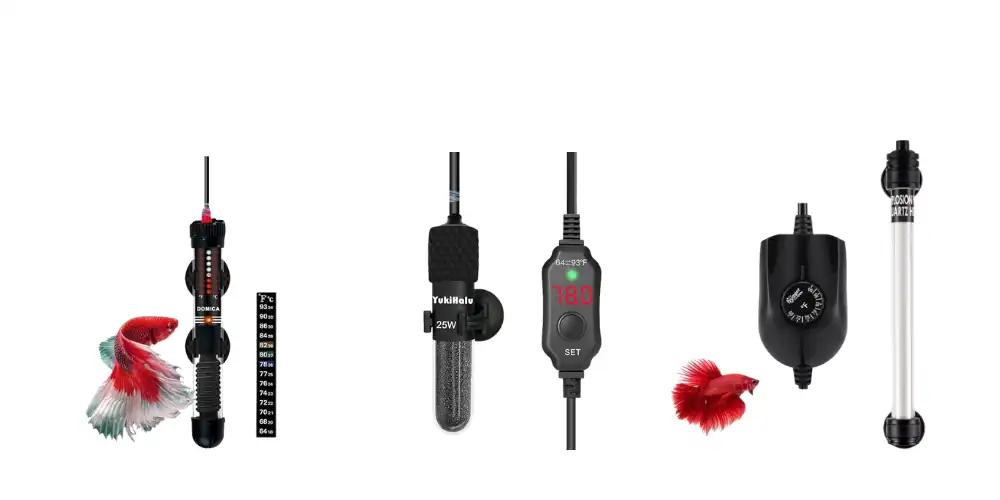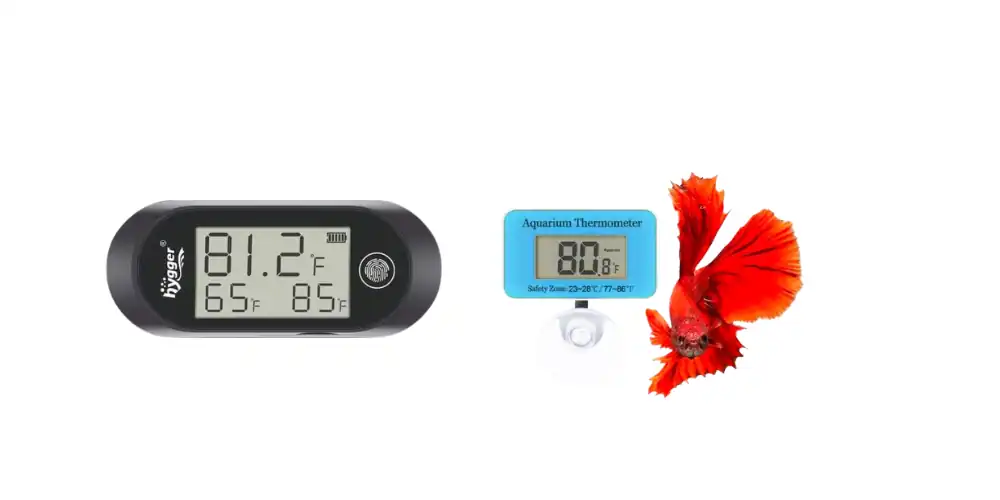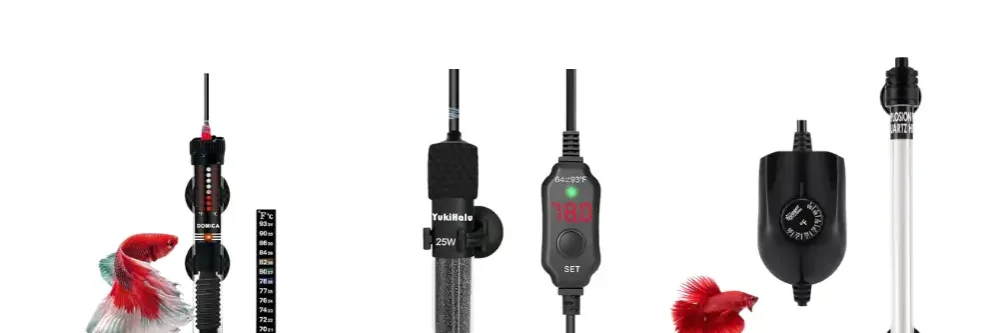A lot of new betta owners wonder, “Do betta fish really need a heater?” You’ll find lots of different advice online, from friends, or even at pet stores, which can get confusing.
It’s easy to feel worried about whether your betta will be okay or if buying a heater is even worth it. This guide will clear things up with simple and science-based facts. You’ll learn why keeping the right temperature matters, what the perfect range is, and we’ll bust some common myths.
Plus, we’ll walk you through how to pick the right heater, set it up, and keep an eye on it so your betta stays happy and healthy for a long time.
Do Betta Fish Need a Heater?
So far, it’s the matter of the heater, we don’t want to simply answer the concerned question as Yes or No. Instead, we’ll dig into the details of all the essential factors regarding betta’s heater requirements. These factors include:
- temperature in betta’s natural habitats
- your room temperature
- temperature fluctuations throughout different seasons
- temperature drop through day and night
A betta may survive without a heater, but a heater is highly recommended to ensure that it thrives and lives its full lifespan (up to 5 years or more).
Temperature in Betta’s Natural Habitats
Betta fish originate from warm, tropical environments, specifically in Southeast Asia. The temperature of these regions ranges from 78°F to 82°F (25°C to 27°C). It can sometimes rise to 84°F but very rarely. However, it’s bearable for betta if it persists for a shorter duration. Any temperature lower than 74°F for extended periods can put them in hard-living conditions.
Your Room Temperature
For those, living in regions where the natural temperature usually remains below the one required for betta i.e., less than 78°F, a heater is absolutely necessary to ensure your betta’s well-being.
On the other hand, if you live in tropical regions where the regional temperature remains higher than the betta’s required one i.e., greater than 78°F or 80°F, you may think of compensating for the heater, but it’s not recommended. Why do we say so? There are several reasons behind this, which we will discuss in the upcoming section.
Temperature Fluctuations and Stability
Betta fish always feel comfortable in stable temperature conditions. In tropical regions, the temperature may stay within an acceptable range without a heater during the summer. But it can fluctuate significantly throughout the year, usually low during cooler months. The fluctuation can be further overplayed over a 24-hour day and night cycle if you use air conditioning in your room.
You may experience significant cooling at night or during the rainy season and a warmer temperature than ideal in summer at midday. Remember, bettas can be severely affected by even a small temperature drop. They can tolerate various temperatures, but rapid changes can shock them adversely. This can result in slower metabolism, stress, and a higher likelihood of diseases like fin rot. This shows how a heater is crucial to add to your aquarium.
Importance of Heater for Betta Fish
Betta fish are so adapted to warmer temperatures that their metabolism can slow down in colder water. Keeping them in less warm water for a long time can lead to lethargy and reduced appetite. It can weaken the betta’s immune system, making them vulnerable to common diseases.
This happens because bettas, like other cold-blooded fish, rely on the temperature around them to control their body functions.
Warmer temperatures can faster their metabolism, which promotes digestion, growth, and healing of the injuries or damaged fins if suffered from swim bladder disease or any other bacterial or fungal infection. A warmer environment helps facilitate breeding and ensures the health of both the fish and their offspring.
If the water gets too warm, it can speed up your betta’s metabolism, making them hyper and dart around a lot. Warmer water also holds less oxygen, so it’s harder for your betta to breathe. If they stay in too-hot water for a long time, it can hurt their organs and shorten their life. Plus, higher temps can cause more unwanted algae to grow. That’s why having a heater is very important to keep the water at the right temperature and keep your betta healthy.
Misconception about Betta Heater
When you are having betta, misconceptions always surround you. Most of the time, they are pet stores’ employees who contribute to these misconceptions. They spread misinformation because they aren’t well-versed in proper betta care, like claiming bettas can live happily in unheated water or small containers. They justify keeping bettas in small and unheated bowls, creating the false impression that this setup is adequate for their long-term care.
This often leads to misconceptions that bettas are easy, low-maintenance pets that don’t require proper heated setups, which is far from the reality. If you want your betta to live a long and healthy life, you need to provide them with a warm, stable environment, which makes the heater an essential component to install.
Types of Aquarium Heaters Good for Betta Tanks
Aquarium heaters work by using a heating element to warm the water, and a thermostat to keep the temperature steady.
For small betta tanks under 10 gallons, these are the main types.
Submersible Heaters
These go fully underwater and can be placed either sideways or upright. They’re easy to place and usually come with a thermostat to keep the water evenly warm. The downside is they can look a bit big in very small tanks and need enough water to cover them.
Preset Submersible Heaters
These are also underwater heaters but are set to one fixed temperature, usually around 78°F. They’re very simple to use, just plug in and forget it. But you can’t adjust the temperature if you want it a little warmer or cooler, and they rely on the factory settings being correct.
Adjustable Submersible Heaters
These let you set the temperature yourself with a dial or control. They’re the most common and great if you want to fine-tune the heat. You do have to keep an eye on them to make sure they’re working right, and they can be a bit trickier than preset ones.
Other types like inline heaters, which work with filters are usually for bigger tanks. Undergravel heaters are old-school and not recommended for bettas.
Choosing the Right Heater for Your Betta Tank
When choosing a heater for your betta fish tank, several factors must be considered so that your betta remains safe and healthy and prevents overheating. Below are the some essential factors to keep in mind.
Tank Size
The heater power should align with the size of betta tank. A general rule is to use a heater of 4-5 watts per gallon of water. For larger tanks above 50 gallons, the power of the heater reduces to 2-3 watts per gallon. However, the final selection depends upon your room temperature and heater efficiency.
For example, for a 5-gallon betta tank, you’ll need to acquire a 20- to 25-watt heater. For a 10-gallon betta tank, you’ll require a 50-watt heater, but if you are dealing with a cold winter, you may require a high-power heater up to 75 watts. Using the wrong wattage can either overheat or fail to properly warm the water.
Adjustable vs. Pre-set Heaters
If your room temperature is fluctuating heavily, you should go with an adjustable heater. It allows you to set the exact temperature you want, giving you more control.
Preset heaters are set to a fixed temperature, usually around 78°F for a betta. Aquarists often recommend these heaters to newbies due to their simple use. However, they may not meet your expectations to find accurate temperature readings in all conditions.
Heater Placement
Heater placement plays an important role in even distribution of heat throughout the tank. For our aquariums, the heater is usually placed near the filter or in an area where water circulation is strong. It gives us the best results in the proper distribution of heat. Uneven heating can create hot and cold spots that can stress your betta.
Compatibility with Other Equipment
Your heater should be compatible with other accessories of betta tank, such as filter, light, and decorations. Sometimes, a high-luminous aquarium light with the combination of a high-power heater can overheat your tank. In such cases, you should consider the contribution of light in increasing the temperature and use the heater accordingly.
The heater should also not interfere with the functions of the tank or other equipment or cause an imbalance in water circulation.
If you have tank mates with your betta, the set temperature should also align with their required temperature.
How Aquarium Heaters Work?
Aquarium heaters warm the surrounding water when electricity flows through its core component, typically made of metal. As mentioned earlier, most aquarium heaters come either as pre-set or adjustable.
The temperature automation of aquarium heaters works with the help of a thermostat. They are intended to turn on and off as per temperature requirements to maintain the temperature at your desired point.
Once the water reaches the desired temperature, the thermostat automatically shuts off the heater to prevent the temperature from further increasing. When the water temperature falls below the set level because of fluctuations in room temperature, the thermostat reactivates the heater, allowing it to maintain a desirable temperature again.
Small Tank Heaters
One of the biggest concerns about heaters is using them in small betta tanks. The betta owners are frightened by its associated problems, such as overheating, fitting issues, and inconsistent performance. Although we don’t want you to keep bettas in small-size tanks, we still care about your limitations and constraints.
Always select a brand heater to avoid the associated problems of small tank heaters. Never go for any unknown brand that has no credibility. Moreover, prefer adjustable heaters over pre-set heaters.
The pre-set ones are not effective enough in smaller tanks of size 2.5-gallon. Even in 5-gallon tanks, non-adjustable heaters may struggle to maintain the optimal water temperature, making fish susceptible to cold stress.
Adjustable heaters provide more control and are generally more effective for small tanks. Adjustable heaters allow you to repurpose larger tanks in the future. A heater of 5 to 25 watts works best for any tank ranging from 1 to 5 gallons, depending on the efficiency and effectiveness of your heater.
Our Recommended Heaters for Smaller Tanks

1. YukiHalu Adjustable Submersible Aquarium Heater
A decent design heater that occupies less space, and can easily be hided in fish tank.
Check it on Amazon
2. FREESEA 25W Submersible Preset Aquarium Heater
If you are not compatible with adjustable heaters and find it difficult to use, the a preset heater like the below will fit your betta aquarium for 1-5 gallons.
Check it on Amazon
Other Recommended Heaters for Larger Tanks
After our testing and based on expert reviews, we consider the following aquarium heaters to be best suited for your betta tank of larger size.
1. Orlushy Submersible and Adjustable 100W Aquarium Heater
The Orlushy Aquarium Heater (Check it on Amazon) enables one to take care of all key considerations necessary for maintaining a stable temperature in the tank, such as precise temperature control, quick heating, and strong suction cups for secure placement.
2. Fluval 50W Submersible Aquarium Heater for Aquariums up to 15-G
We currently have a Fluval M50 Aquarium Heater (Check it on Amazon) in our 10-gallon betta tank. This heater can maintain a steady temperature, which is crucial for betta fish. It also does not bother your betta nor affect the tank equipment.
3. Aqueon Adjustable PRO Aquarium Heater Up to 20 Gallons, 50 Watts
This tank heater (Check it on Amazon) is known for maintaining a consistent temperature (usually within 1°F of the set point), durability, even distribution of heating, and ease of use. Its adjustable settings to a precise level are amazing, which helps you set the temperature to a higher degree for specific requirements like fin rot.
External Temperature Controllers
Most of the heaters come with external temperature controllers. However, if one misses it, you should consider buying it separately. It helps you prevent overheating in your tank.
These controllers, like the Inkbird temperature controller (Check it on Amazon), cut off the heater power supply once the preset temperature is reached, protecting your tank from accidental overheating.
Installing Your Betta Heater
Placing and Setting Up the Heater
Just like maintaining the temperature is important for betta fish, the placement of its heater matters even more. Start by picking a good spot in your tank where water flows well, near the filter output is best. Attach the heater firmly to the tank wall using the suction cups or clips it came with. If it’s a submersible heater, make sure it’s completely underwater.
Let the heater sit in the tank for about 15–20 minutes before plugging it in so the glass can adjust to the water temperature. If the heater has a temperature control, set it to 78–80°F, which is ideal for bettas. Then, plug it in.
Safety Tips You Shouldn’t Skip
Always unplug the heater during water changes, running it dry can cause it to crack or overheat. After refilling the tank, make sure the heater is fully underwater before plugging it back in.
Before using, check the cord for any damage. Also, create a drip loop (let the cord hang lower than the outlet) to keep water from running into the socket.
Post Setup Care
It may take a few hours for your tank to reach the right temperature. Watch your betta closely after installing the heater. If they’re swimming normally and acting relaxed, the temperature is likely just right.
Need of Aquarium Thermometers
A heater keeps your tank warm but it doesn’t show you the actual temperature of the water. You might consider an aquarium thermometer for precise measuring of your tank temperature. This little investment prevents your tank from overheating or under-heating, especially in the case of sensitive species like bettas that thrive in stable and warm environments.
Aquarium thermometers help you double-check that the heater is working right and the water isn’t too hot or too cold in some spots.

Heaters can mess up sometimes, so it’s smart to keep an eye on the real water temp, especially if your tank doesn’t have strong water movement.
Always use a good thermometer to make sure the temp stays in the safe range for bettas—78–80°F (25.5–26.5°C).
Types of Thermometers
1. Stick-On LCD Thermometers
These are the ones you stick on the outside glass of your tank. They’re flat, easy to read, and cheap. They show the temperature using color changes or numbers that light up depending on how warm it is.
Since they’re stuck on the outside, they don’t measure the water directly, just the glass surface. That means the reading might be a little off, especially if your room temperature changes a lot. They’re okay for a glance but not the most accurate choice.
2. Submersible Glass Thermometers
These are the classic glass ones you place inside the tank. They float or stick to the inside glass and give you a more accurate reading of the water temperature.
They’re simple and usually come with a little suction cup to hold them in place. Just be careful as they’re made of glass, so they can break if bumped or dropped. You’ll also have to look inside the tank to read them, but they do the job well.
3. Digital Thermometers
These are the most modern options. You stick the sensor inside the tank, and the screen (usually attached to the tank or nearby) shows the temperature digitally. Some even come with alarms that beep if the water gets too hot or too cold.
They’re very accurate and easy to read, no guessing. The only downside is that they cost more than the other types, and you’ll need to change the batteries now and then. Still, they’re handy if you want to keep a close eye on your tank temperature without having to squint or stick your head in the tank.
Zacro Digital Aquarium Thermometer (Our Recommended)
Check it on Amazon
The Zacro LCD Digital Aquarium Thermometer is more accurate than stick-on thermometers because it uses a probe that goes directly into the water. It shows the temperature clearly on a digital screen and usually matches closely with the reading on the aquarium heater, which helps ensure the water stays at a safe level.
It’s useful to have two, one for the tank and other for checking new water during water changes. Although it doesn’t have a backlight, so it’s hard to see in the dark, and the battery can be a bit tough to remove. Despite these all, we still consider it a reliable choice. It’s great for spotting sudden temperature changes and for checking if the whole tank is heating evenly, especially the side farthest from the heater.
Our Final Perspective
Summarizing our discussion about the most debated question, do betta fish need a heater? We can confidently say that aquarium heaters are crucial for tropical fish, particularly betta. Although a betta fish may survive without a heater for a few days to week, it is necessary for its longevity and thriving life.
Using a heater keeps you on the safer side. They are inexpensive and energy-efficient, and they protect your fish from potential temperature fluctuations, even if the room temperature seems ideal most of the time.




